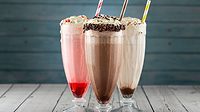Energy Exchange
By JENNIFER ZEGLER
Production of Monster Energy drink calls for a network of co-packers and distributors
In order to produce the 35
million cases of Monster energy drinks that are sold each year, Hansen
Natural Corp., Corona, Calif., has created several partnerships. The
company has a network of regional co-packers and distribution warehouses
for production and storage of its carbonated, juice-based and dairy-based
line of energy drinks. The variety of formulations are a boon to
Monster’s portfolio, but have required additional partnerships with
appropriate co-packers.
“Our network has continued to grow at a rapid
rate,” says Gareth Bowen, senior vice president of operations.
“Monster alone in 2006 utilized six co-packers, and in 2007
we’ve used 11 co-packers. It provides benefits in that we’re
able to have more national distribution. It makes it easier to meet orders
on time and to ship shorter distances.”
A co-packer near Hansen’s Corona, Calif.,
headquarters produces Monster’s “green,” Lo Carb and
Assault varieties. The plant receives empty Monster cans by truck in full
pallets, which are stored onsite until needed. As with all its co-packers,
Hansen’s provides plants with the necessary materials and
ingredients.
Produced on a traditional carbonated soft drink line,
green Monster cans wind through the filler, which loads the cans with
regular Monster and then caps and seals the packages. The cans are then
checked for fill level and caps are washed. Once the products are checked
again and dried, they travel up a vertical ramp to the case packer.
During Beverage Industry’s visit, the line was packing 24-can club packs of
16-ounce regular green Monster. From the case packer, the club packs travel
to the shrinkwrapper. Plant workers ensure the pallet is display ready for
retailers.
Once the pallets are shrinkwrapped and loaded onto a
truck, they are transported from the co-packer to Hansen’s
distribution facility in Corona. The 400,000-square-foot distribution
facility is located down the street from the company’s headquarters.
The Corona warehouse stores pallets of Monster,
Hansen’s allied energy drink brands, fruit beverages and some private
label products. The brands’ point of sale materials, additional
merchandise and event trucks also are stored at the facility. In addition,
the Corona warehouse is capable of repacking cases. During Beverage Industry’s visit,
employees were repacking 24-packs of Monster Lo-Carb to create 12-packs
that featured a special flyer.
While the aisles in the distribution center are filled
with Monster’s multiple varieties, Geoff Bremmer, Monster brand
manager, points out pallets of popular new introductions, such as green
Monster 24-ounce resealable “cap cans” and Java Monster. The
products generally were out of stock so once the pallets were received in
the warehouse, they were immediately shipped to fulfill orders.
“With Java Monster, the demand has been so great
we haven’t been able to fill all orders,” says Bowen. “It
blew away all our initial forecasts and made us scramble to find additional
capacity. In November, Java Monster was produced at six times our initial
projections.”
Similar stock issues were experienced with
Monster’s four-packs that had traditional retailers asking for more
at the end of the summer, Bowen says. The four-packs as well as eight-packs
are allowing for improved velocity in grocery stores, while the convenience
sector remains the brand’s main focus.
“Convenience stores are our first target because
it’s such an important part of our business, and convenience stores
are often more open to new products,” Bremmer says.
According to Bremmer, the convenience channel makes up
about 70 percent of Monster’s sales. Monster works with its network
of independent distributors to ensure its products are always on store
shelves. The success of green Monster has opened the door for
Monster’s innovations, he says.
“Our flagship Monster SKU sales continue to grow
in the channel,” Bremmer says. “We’re putting in more
SKUs, and velocity sales per outlet on Monster green 16-ounce continue to
rise. Generally sales for the flagship product of most brands is the most
critical and sales for our flagship have never dipped. The product
continues to grow despite line extensions and multi-packs.”
The company maintains a nationwide network of
convenience store-focused representatives, which it calls trade development
managers. Monster employs 100 trade development managers nationwide who
take the time to go into local stores set shelves, sell SKUs and bring in
point-of-sale items.
“The trade development
managers are experts in their own local area,” Bremmer says.
“It’s a time-consuming and important task. Not every
merchandiser can accommodate every SKU and put up P.O.S. inside and outside
the store. The trade development managers are in the market and have the
time, so if they need to take apart a shelf and reorganize it,
they’ll do it. It’s a service level that our company has
provided from the start.”
To make sure the product is consistent across its
network of co-packers in Southern California, Texas, Florida, the
Carolinas, Minnesota and Missouri, samples of Monster are shipped from the
co-packer to Hansen’s Quality Control Department. In its facility,
which is adjacent to the Corona warehouse, Hansen employees test the
blended products.
Since May 2006, Hansen has
had a distribution arrangements with many
Anheuser-Busch distributors for Monster and two other affiliated energy
drinks. The Anheuser-Busch network is now one of Hansen’s primary
distributors, but it is not an exclusive agreement, Bowen says. The company
still has licensing agreements with various distributors in many
territories by brand and by channel.
“We strive to streamline the supply chain and
utilize services they offer so the product is in the right place to
maximize sales,” Bowen says.



